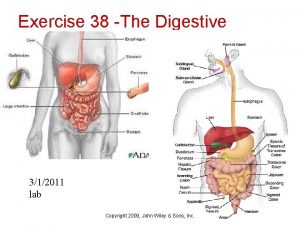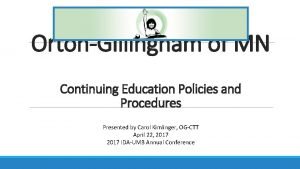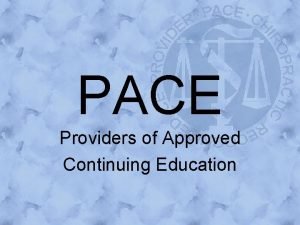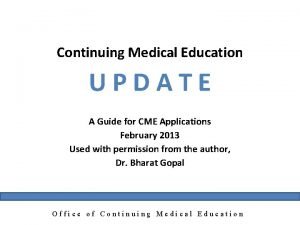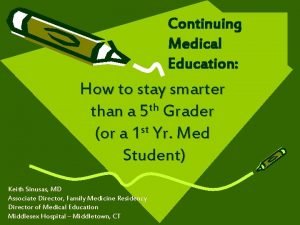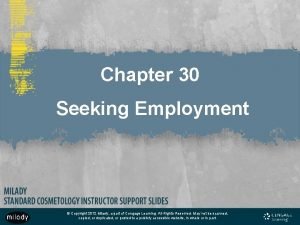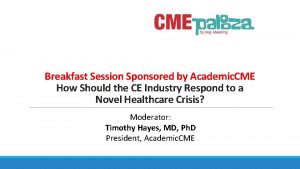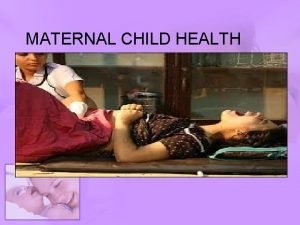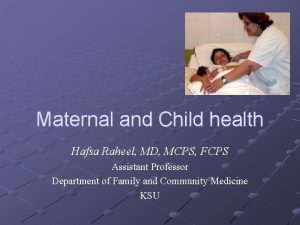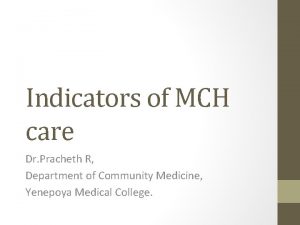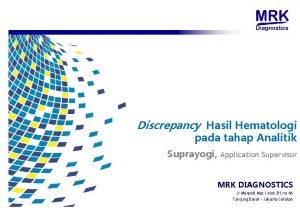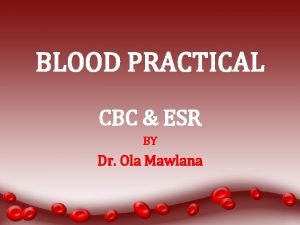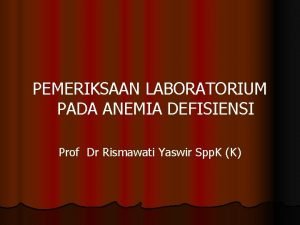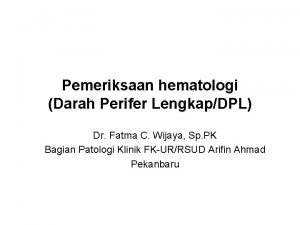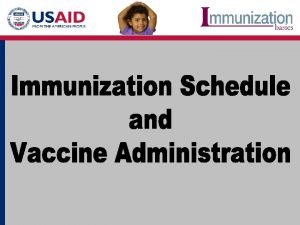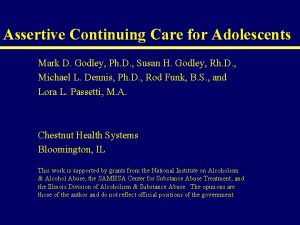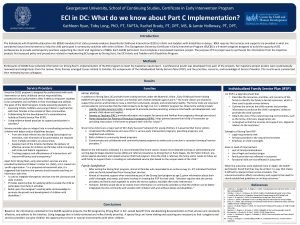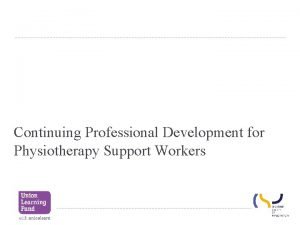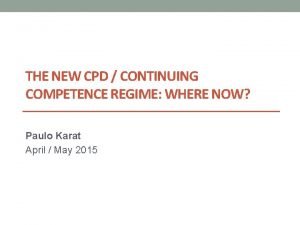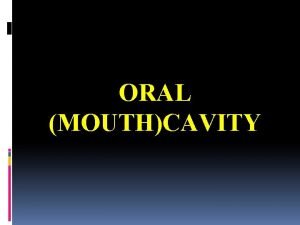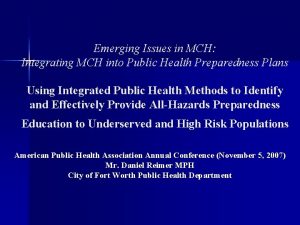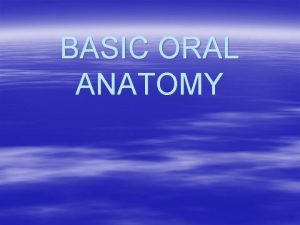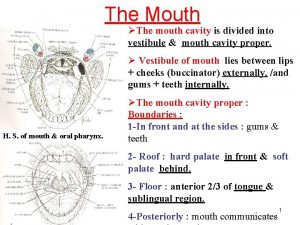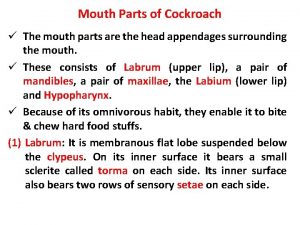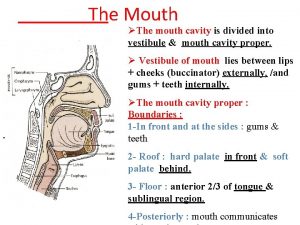Opening the Mouth Continuing MCH Education in Oral





























































- Slides: 61

“Opening the Mouth” Continuing MCH Education in Oral Health Columbia University School of Dental and Oral Surgery Division of Community Health

Learning Objectives w Understand the connection between oral health and overall health w Understand that dental caries is an infectious, transmissible, communicable disease w Understand the prevalence, acuity and consequence of dental disease w Understand dental care finance, delivery and workforce w Identify Title V opportunities for intervention

Oral Health and Health Care Introduction: w Despite great strides in improving oral health, disparities still exist across population groups of all ages. w The Surgeon General reports: “those who suffer the worst oral health are found among the poor of all ages, with poor children and poor older Americans particularly vulnerable. Members of racial and ethnic groups also experience a disproportionate level of oral health problems. Individuals that are medically compromised or who have disabilities are at a greater risk for oral diseases, and, in turn, oral diseases further jeopardize their health”(1).

Oral Health and Health Care w Tooth decay remains the single most common, chronic disease of childhood; 5 x more prevalent than asthma (1) w Children suffering the highest rates and most severe dental disease tend to be preschool-aged and disadvantaged by poverty, minority status or social conditions. w Approximately 25% of children under age 19, account for 80% of the dental disease. w Dental disease, untreated, results in pain, infection, and may inhibit general growth and development (2) w Periodontal disease and chronic oral infections are considered a risk factor for heart disease, inadequate glycemic control in diabetics and more recently, poor pregnancy and birth outcomes.

Oral Health and Health Care Healthy People 2010 w “Oral diseases and conditions may have a significant impact on general health…. . Oral health care is an important, but often neglected, component of total health care. Regular dental visits provide an opportunity for the early diagnosis, prevention, and treatment of oral and craniofacial diseases and conditions for persons of all ages, as well as for the assessment of self-care practices”. (3)

Part I: Conception to Birth w Meet Mrs. Perez. She is a 32 -year-old, Hispanic mother of 2 children, under the age of 6 years, and pregnant for her third. w She presents to the dental clinic at her local community health care center, complaining of “bleeding gums and loose teeth”. w Her dental pain has progressed to the point that eating has become difficult. w Mrs. Perez was unable to attend the clinic prior to today, as she could not afford to pay for the dental treatment, not to mention child-care for her 2 children and the cost for public transportation. w The private dentist located “relatively” close to her inner-city home, informed her that he “does not accept Medicaid”. w After her examination, the dentist informs Mrs. Perez that she has periodontal or “gum” disease.

Periodontal Disease n n n n The case of Mrs. Perez is unfortunate, but commonplace in community health center dental clinics. The reality of this case? Hispanic and African American populations have higher rates of oral disease and tooth loss than the white, non-Hispanic majority population Approximately 26% of adults aged 18 -34 years, do not have health insurance (1) 72% of adults not obtaining dental care state that the major reason is financial (4) Few dentists participate in the Medicaid program (approx 1/3 of dentists provide at least one dental appt under medicaid, & only 14% are active medicaid providers, i. e. . billing > $10, 000 as a percentage of total active patients) (5) There is a decline in the number of dentists per 100, 000 people and it is anticipated this shortage will increase over time. As of June 2003, 2112 dental health professional shortage areas have been identified. It would take 8481 additional dentists to achieve a target dentist-to-population ratio of 1: 3, 000. (6)

Periodontal Disease n n n The number of underrepresented minorities in the dental profession is significantly low compared to their proportion in the overall population (5. 7% of graduate dentists are African American and 5. 3% are Hispanic; These percentages are far below the percentage of African American (12%) and Hispanics (11%) in the general population) (7). Thus, patients may be faced with language barriers and/or cultural incompetence. Safety net facilities (e. g. dental schools, community health centers, hospital clinics and mobile vans) are few in number compared to the medical safety net (primarily because community hospital emergency rooms comprise a major component of the medical safety net, whereas emergency rooms typically only offer palliation with medication for dental complaints. In addition, there are 4 x as many medical schools than dental schools. Although only 1% of Medicaid expenditures is related to dentistry (0. 5% for children)(8), fiscal demands have led to reductions in, or elimination of dental benefits for adults and the disabled. In 2003, only 8 States had comprehensive adult dental coverage under Medicaid, while 43 States had no coverage or limited coverage (53)

Periodontal Disease: Poor Birth Outcomes w w w Despite pain and discomfort, some women never present for care (Fact: less than two thirds of adults reported having a dental visit in the last year{1}). What happens if Mrs. Perez does not receive the necessary dental treatment for her periodontal disease? The most obvious consequence will be continued mouth pain, disease progression and eventual tooth loss. But what about the systemic effects of her periodontal disease? How will her oral disease affect her pregnancy or her unborn child? Learning Objectives: n n n What is the association between periodontal disease and poor birth outcomes Putative Biologic Pathway Putative effectiveness of intervention & evidence for intervention

Periodontal Disease: Poor Birth Outcomes Periodontal Disease: w w w Periodontal disease (periodontitis or “gum disease”) is a chronic infection caused by bacteria existing at the gum line in the form of plaque and calculus (“tarter”). (Picture of periodontitis – Papos Papapanou- waiting for picture) Periodontal disease causes inflammation and bleeding gums and, if not treated, leads to tissue destruction, tooth mobility and eventually tooth loss. Growing body of research supports an association between periodontal disease and Pre-term low birth-weight (PLBW) (link to studies further on in module)

Periodontal Disease: Poor Birth Outcomes Preterm Low Birth-weight: n n n PLBW pregnancy outcomes in the U. S. remain a concern because of the significant consequences to maternal and child health, high costs, long-term disease burden, and individual suffering. Economic consequences exceed $5 billion annually Accounts for 6 -9 percent of all births (9) Centers for Disease Control maintains that the second leading cause of infant mortality is premature/low birth-weight (10) Accounts for 70% of all perinatal deaths and 50% of long-term neurologic morbidity (9) NIH reports that “as many as 18% of the 250, 000 premature low-weight infants born in the United States each year may be attributed to infectious oral disease” (call out box? )(11)

Periodontal Disease: Poor Birth Outcomes State of the Science: Known causes of PLBW, that may be medically managed, include asthma, cigarette smoking, bacterial vaginosis and diabetes However, much of its incidence remains unexplained Classic measures for association between periodontal disease and poor birth outcomes, are being explored and show likely causality Based on this emerging science, there is hope that the severe developmental, behavioural, health and economic consequences of PLBW may be minimized by improving oral health during pregnancy n n

Periodontal Disease: Poor Birth Outcomes State of the Science: w Animal Studies n n Inducing experimental periodontitis in animals, leads to significantly smaller litter weights (12). These animals show higher levels of blood-borne chemical mediators that are responsible for causing uterine contraction, cervical dilation, labour and abortion (13).

Periodontal Disease: Poor Birth Outcomes State of the Science: w Humans studies: n n The association was first identified by secondary analysis of NHANES III (13) One case-controlled study, after adjusting for all other risk factors (e. g. tobacco use and maternal age) found that women with periodontal disease had 7 times the risk of delivering a PLBW baby (13). More recent human studies following women through pregnancy, compares favourable and unfavourable birth outcomes. Preliminary results indicate that mothers with advanced periodontitis have a higher risk of delivering a PLBW infant. (14, 15) NIH supported, multicenter, RCT studies are currently underway

Periodontal Disease: Poor Birth Outcomes Effectiveness and Evidence for Intervention: w Can treating periodontal disease in pregnancy reduce poor birth outcomes? n Two studies have shown an association between treating periodontal disease during pregnancy and improved birth outcomes (16, 17) n For the mother, there are no known negative consequences associated with improving the oral health of pregnant women. The positive is that it may reduce poor birth outcomes, which is a considerable benefit for the child. Thus, there is great enthusiasm in promoting optimal oral health during pregnancy.

Dental Care for Pregnant Women The National Healthy Mothers, Healthy Babies Coalition (HMHB): n n Issued a statement of position that “oral health care during pregnancy is crucial and should be available to all women, regardless of income level”. They are committed to “working with dental and other health care providers to increase awareness of, and support research on, the possible link between periodontal disease and pre-term, low birth-weight babies” (18) See The National Healthy Mothers, Healthy Babies Coalition Position Statement on Oral Health and Pregnancy at www. Hmbh. org/ps_oral health. html American Academy of Periodontology: n n Has recently developed a draft policy statement that recommends pregnant women have a periodontal examination performed and appropriate preventive and/or therapeutic services provided, as there is immerging evidence that women with periodontal disease may be more at risk to deliver a preterm low birth weight baby (August 2003) See the AAP website @ www. perio. org

Dental Care for Pregnant Women w Clinical guidelines suggest that routine plaque and calculus removal via polishing, scaling and curettage, can be performed safely during pregnancy, regardless of trimester (19) w Dentists and obstetricians agree that routine dental care should be maintained throughout pregnancy. (20, 21) Despite the growing evidence and literature to support the association between periodontal disease and PLBW, it has not been widely translated into clinical or public policies. w

Oral Health Programs for Pregnant Women w w Medicaid programs, administered by the states within federal guidelines, are required to provide certain populations with specified (“mandatory”) benefits. Dental is only mandated under Early and Periodic, Screening, Diagnostic, and Treatment Services Program ( EPSDT). Dental coverage for pregnant women (+ 21 years) currently is not a “mandatory” benefit (see note) Pregnant young women (< 21 years) that are covered by Medicaid, must be enrolled under the EPSDT to receive comprehensive dental benefits (22) Centers for Medicare and Medicaid Services (HCFA) Medicaid Services State by State, October 1, 1996. HCFA Publication 02155 -97. w California: first in the nation to extend dental benefits to pregnant women n Adult women and minors who are pregnant become eligible for either adult dental coverage (if over the age of 21) which includes periodontal treatment or the full range of EPSDT dental services, which also include periodontal treatment (23) Note: Louisiana and Utah have recently added benefits – Waiting for info from Ann De. Biasi at CDHP (Insert this in a “popup” box ? )

w In California, with the addition of preventive periodontal to the scope of Medi. Cal benefits for women in the pregnancy services only and pregnancy and emergency services only aid categories, the estimated savings for fiscal year 2004 -2005 is $24, 427, 000 (23). w (Based on the estimate that in FY 2003 -2004, the number of Medi-Cal low birth -weight babies attributable to periodontal disease is estimated at 2, 655. The average neonatal savings per child is $22, 000. Approx. 50% of women will complete sufficient preventive periodontal care to bear a normal birth-weight infant

w w Mrs. Perez was unable to undergo periodontal treatment as she could not afford to pay for the service. Six months after her visit to the health center dental clinic, she delivers a preterm low birth-weight baby girl. Fortunately, with advances in neonatal care, survival rates of pre-term, low-birth-weight babies have dramatically improved. Unfortunately, studies indicate that pre-term children suffer from a multitude of acute and long-term problems, including significant delays in physical and psychological growth and development of all structures, including the craniofacial complex and teeth Oral structures, like other tissues, are affected by prematurity and low birth- weight (24)

Part II: Early Childhood Tooth Decay w w w Meet 12 month-old Maria Perez. During Maria’s well-baby exam at her primary care physician’s office, Mrs. Perez states that Maria’s front teeth “didn’t look right” when they erupted. The health history indicates that Maria was a pre-term infant (i. e. . < 37 weeks gestation) with a low birth weight (i. e. . < 2500 gm). Her physician takes a brief look, reassures Mrs. Perez that it is a “developmental problem” and suggests if she has further dental concerns, that she should see a dentist. He does not write a referral letter.

Early Childhood Tooth Decay w Learning Objectives: n n n What is early childhood tooth decay Prevalence, acuity and consequence of early childhood tooth decay Infection and transmission Current treatment (Restorative dentistry) Emerging treatment (Prevention and disease management)

w w The goal of an early dental assessment is primary prevention (see slide 36). This may be accomplished with the timely delivery of oral health information, including the conditions that create caries & cavities; its natural progression; and its prevention (Anticipatory Guidance – see slide 37), and the identification of populations at high risk for tooth decay, The traditional approach of treating the effects of dental decay (i. e. . “drilling and filling”) is being replaced by disease prevention and disease management. Prevention focuses on the establishment and maintenance of good oral hygiene, optimizing systemic and topical fluoride exposure, and eliminating prolonged exposure to simple sugars in the diet. Prevention is the foundation for the establishment of a “dental home” by 1 year of age. The concept of the "dental home" is derived from the American Academy of Pediatrics concept of the "medical home. " This concept states that “the primary health care of infants, children, and adolescents should be accessible, continuous, comprehensive, family centered, coordinated, compassionate, and culturally effective. It should be delivered or directed by well-trained child health specialists who provide primary care and help to manage and facilitate essentially all aspects of pediatric care” (25).

w As young as this child is, both developmental and acquired disease are already evident on examination. Active Disease: w Maria was noted to have thick plaque and decalcification (mineral loss) on her primary teeth (red arrow). The gingival tissue appeared shiny and full (blue arrow), indicating inflammation. Developmental Findings: w Notching of incisors (yellow arrows), eruption hematoma (purple arrow), atypical eruption sequence (pink arrow), and an anatomical variant of the labial frenum (green arrow)

Caries Risk Assessment w w w Advances in the understanding of dietary influences and fluoride on dental disease become instrumental in supporting early intervention Every child should have an examination and oral health risk assessment by 12 months of age by a dentist or qualified pediatric health care professional. (26) The Caries Risk Assessment Tool (CAT), provided by the American Academy of Pediatric Dentistry (27), was designed to assist both dental and nondental health professionals in assessing the risk of tooth decay in infants, children and adolescents. The CAT can be used to determine the relative risk of caries of the patient Questions directed at dietary practices, fluoride exposure, oral hygiene, utilization of dental services, socioeconomic status and general level of health can help determine if a child is at low, moderate or high risk for dental disease. Using the CAT ( http: //www. aapd. org/members/referencemanual/pdfs/0203/Caries%20 Risk%20 Assess. pdf ), and Maria’s history (low socioeconomic status and no usual source of dental care) and exam findings (thick plaque, areas of demineralization and gingivitis), Maria would be considered at high risk for dental disease.

w Maria’s main problem is the abundant plaque on her front teeth. w Visible plaque on the front teeth, is positively correlated with caries development by age 3 (28) (Call out box? ) w The primary components of dental plaque are bacteria. Acid, produced by these bacterial species (mainly Streptococcus mutans) is considered the most important activity in the production of tooth decay. w Maria, being a low birth-weight infant, is at risk for enamel hypoplasia, as 20 % of low birth-weight children are affected. w Enamel hypoplasia is defined as a deficiency in enamel formation, that manifests clinically as grooves or pits, or a lack of surface enamel (29). These surface irregularities act as “plaque traps” allow for an increased colonization of harmful bacteria and increase Maria’s risk for developing cavities.

w It is too late for Maria to gain the advantage of primary prevention and some aspects of anticipatory guidance, as she already exhibits signs of dental disease. w Maria is not too late for disease suppression (see slide 39). With proper diet control and the application of topical fluoride, Maria may have avoided surgical intervention. Unfortunately, without a timely referral, disease progression is inevitable.

w w w Maria is now 33 months old. She has presented with her mother to the local health center dental clinic, because, according to Mrs. Perez, Maria has “been up all night, crying about her teeth”. Dental History- in the last 2 months, Maria has become increasingly irritable at mealtimes. It began as whining with cold or sweet foods, and has progressed to crying when biting with the front teeth. For the last 3 nights Maria has awoken from sleep and Mrs. Perez was able to console her with her usual bottle of apple juice. Last night, she was inconsolable and required pain medicine (“oral numbing gel”) to help her sleep. Mrs. Perez did not take Maria to the dentist before, as her local dentist doesn’t except medicaid and she is aware of the unpredictable wait and long hours for walk-in “emergencies” at the health center. Additionally, Mrs. Perez stated that since these are Maria’s “baby teeth”, that they will “just fall out anyway, so why bother fixing them”. Maria’s upper (maxillary) teeth, with severe early childhood tooth decay

Failure of Early Intervention? Tooth decay in the primary teeth, has significant functional and disease progression consequences: Disease n Since the mouth is the locus of disease, and not all the primary teeth are replaced simultaneously, disease in the primary teeth will spread to the incoming permanent teeth. Dental disease impacts all the new teeth as they become available, and because the exchange takes so long (12 -13 years), children that have untreated, active oral disease are at an increased risk for more generalized, severe tooth decay. Child n As can be seen in Maria’s case, early childhood tooth decay in the primary teeth, if not cared for, results in chronic pain, infection and sleepless nights. It may also lead to poor weight gain, the inability to eat (2) and affects overall quality of life. (30) Dentition n Loss of primary teeth impairs mastication, affects the development of the craniofacial system, and results in loss of arch space for the succeeding permanent teeth to “grow in” (erupt) into the proper position.

w Maria is diagnosed with severe early childhood caries or “tooth decay”. Maria’s upper (maxillary) teeth, with severe early childhood tooth decay

Early Childhood Tooth Decay What is dental caries? w w Dental caries, better known as “tooth decay”, is the disease process that leads to the loss of tooth mineral and eventually, cavitation of the tooth surface (“cavity”). It is a dieto-bacterial, infectious, transmissible, oral disease. Three things are required for dental caries activity to become established: one or more susceptible tooth surfaces, "cariogenic“ (decay causing) bacteria and fermentable carbohydrates (particularly sucrose). What is early childhood caries? w w Early childhood caries (ECC) or early childhood tooth decay, previously termed “nursing caries” or “baby-bottle tooth decay”, is a particularly virulent form of tooth decay, that affects the teeth of infants and preschool children. It results from an overgrowth of specific organisms that are a part of dental plaque (sticky white or yellow film found on the tooth surface). Although numerous types of bacteria live in the mouth, tooth decay results from the overgrowth of specific cariogenic (decay causing) organisms. Studies demonstrate that children with early childhood tooth decay, have Streptococcus mutans (S. mutans), counts that exceed 30% of the cultivable plaque flora (31 -33). Conversly, in children with negligible to no caries activity, S. mutans comprises less than 1% of total cultivable flora (34). Thus, S. mutans have been implicated as the most likely infectious etiologic agents of tooth decay (35).

Transmission: w w Infants are colonized with the eruption of the primary dentition at approximately 6 to 30 months of age. The primary caregiver of the infant, frequently the mother, has been shown to be the most likely source of inoculation of an infant’s dental flora. There are no studies that explain absolutely how transmission occurs, however, examples include cleaning the baby's pacifier in the mother's mouth before giving it to the baby, sharing utensils or pre-chewing the baby's food. Transmission and colonization of S mutans depends on the magnitude of the innoculum. Higher levels of S mutans are associated with untreated tooth decay, thus, infants of mothers with untreated tooth decay are at higher risk of acquiring the bacteria (36)

Acid Production and Demineralization: w w Decay causing bacteria ingest sugar and other fermentable carbohydrates and produce acid as a by-product, causing a drop in the plaque p. H. The acid attacks the outer surface of the tooth (enamel) for approximately 20 minutes, resulting in mineral loss (demineralization). Perhaps the single strongest predictor of disease acquisition and progression, is frequency (rather that quantity or source) of fermentable carbohydrates (e. g. sweetened milk, juice, soda). (CALL OUT BOX? ) “White Spot lesions” - Clinically, this is the first detectable stage of tooth decay. It is an area of demineralization, characterized by a chalky, white appearance. Although white spot lesions represent loss of mineral from the tooth, the loss is localized mainly in the subsurface of the enamel. The enamel surface in the incipient lesion is essentially intact and amenable to remineralization. THIS STAGE IS REVERSIBLE. “Cavities” - When demineralization exceeds remineralization as a result of frequent or prolonged acid attacks, the result is a breakdown of the enamel, and the formation of a hole or “cavity” in the tooth surface. This is a late-stage sign of tooth decay. Cavities are not reversible, but can be arrested with intense diet control and oral hygiene and topical application of fluoride.

Early Childhood Caries w w w Despite it being easily preventable, ECC continues to be a public health issue. Dental caries affects approximately 1/5 th of preschoolers, ½ of second graders (3, 36) 80% of tooth decay is concentrated in 25% of children (37) Low income children, who suffer the most from dental disease, have the least access to care Call-out box: Low income pre-schoolers are twice as likely to experience caries, twice as likely to experience dental pain, have more than twice the extent of dental disease, and are twice as likely to have insurance coverage because of medicaid, but are only ½ as likely to have a dental visit because of lack of access (CDHP 38) Dental disease, untreated, results in pain, infection, and may inhibit general growth and development (2)

Early Childhood Tooth Decay: Classical Treatment w Classical treatment typically involves surgical removal and/or restoration of carious teeth. Due to age appropriate inability to tolerate outpatient surgical treatment, coupled with the extent of restorative needs, Maria will be treated under general anesthesia. w In the U. S. , the initial cost of treating a child in the operating room for severe caries, exceeds 5 million dollars annually. (39)

Early Childhood Tooth Decay: Classical Treatment w w Unfortunately, restorative dentistry alone, has had minimal impact on outcomes of children with early childhood tooth decay because it is non-therapeutic in that it doesn’t impact the underlying disease process. Relapse remains high and children frequently require a second general anesthetic. (40 -43) Dental restorations are “prosthetic”, rather than therapeutic, in that they function to replace missing tooth structure, but the majority of restorations are not bioactive (the exception are glass-ionomer cement restorations that release fluoride). Early childhood tooth decay is a risk factor future caries and is a good indicator of future caries experience (42, 44 -46). Thus, the initial cost of treatment grossly underestimates the long term cost. With the knowledge that tooth decay is an infectious and transmissible disease, that it is diet dependent and fluoride mediated, and that restorative dentistry has minimal impact on outcomes, the emerging trend in dentistry focuses on Disease Prevention and Disease Management.

Early Childhood Tooth Decay: Disease Prevention w True Primary Prevention – prevents disease occurrence by avoiding disease determinants. In tooth decay, this relates to reducing the reservoir of bacteria, reducing transmission and reducing colonization of cariogenic bacteria. (Reservoir vector receptor). n n n Reducing the reservoir: xylitol chewing gum (use of xylitol containing chewing gum has been shown to inhibit mutans streptococci colonization and reduce the caries experience in children (47, 48)stannous fluoride and chlorhexidine (with dental repair) Reducing transmission: avoid sharing utensils, cleaning pacifier in mouth etc. Reducing colonization: oral hygiene (brushing with fluoridated toothpaste), diet control (reduce frequency of carbohydrates) and topical fluoride application (e. g. fluoride varnish)* Role of Fluoride: 1. Antibacterial action on plaque bacteria 2. Inhibits demineralization 3. Enhances remineralization

Early Childhood Tooth Decay: Disease Prevention PATHOGENIC FACTORS Cariogenic Bacteria Frequent Carbohydrate Ingestion Reduced Salivary Function TOOTH DECAY PROTECTIVE FACTORS Reduce the Reservoir Dietary Control Fluoride Optimal Oral Hygiene Saliva (Flow/Components) HEALTHY TOOTH

Early Childhood Tooth Decay: Disease Prevention Primary disease prevention may be achieved with early intervention and anticipatory guidance: w Anticipatory guidance n w w In dentistry, this involves informing parents of the conditions that create caries & cavities; its natural progression; and its prevention. Dental Home n The concept of the “dental home” is derived from the American Academy of Pediatrics concept of the “medical home” (49). It affords the opportunity for prevention. n Goal is to reduce risk of preventable disease n Provides risk assessment; tailored counseling; anticipatory guidance; emergency plan; access to comprehensive dental care, including any necessary referrals Age One Dental Visit n n n Accepted policy by ADA, Pediatric Dentists, Pediatricians, and Public Health Association Intended to allow for true primary prevention, establishment of dental home, and ongoing anticipatory guidance (50) Consists of history, risk assessment, examination, tailored anticipatory guidance, and counseling

Early Childhood Tooth Decay: Disease Prevention w Secondary Prevention – prevents disease by maintaining a state of balance between disease and health. A state of oral health is not absence of activity, but rather a balance of activity. The teeth are in a constant state of demineralization (loss of mineral) and remineralization. When demineralization exceeds remineralization, the earliest signs of tooth decay (“white spot”) begin, however, at this point it is reversible. Remineralization can occur when there is a balance between diet, oral hygiene and fluoride exposure.

Early Childhood Tooth Decay: Disease Management w Disease Management – when children have not had the benefit of primary prevention and anticipatory guidance, and caries activity has progressed to the point that there is tooth destruction, the following concepts are employed: n Disease Suppression: this is suppression of the disease (caries activity) before repairing the teeth. It involves intensive diet control to reduce frequency of acid attack on teeth, fluoride applications to increase remineralization and resistance to attack and gross caries excavation to decrease bacterial load. n Disease Arrest: once caries activity has been suppressed, affected teeth will have lost tooth structure (“cavity”) but will be dark or glassy in appearance and will not need to be restored unless it is an issue of function or esthetics. Dark brown/black discoloration: Arrested Disease

TOOTH DECAY Decay Causing Bacteria Carbohydrates Acid Mineral Loss Acid Acid DEMINERALIZATION SUG AR TOOTH DECAY

TOOTH DECAY Saliva (Minerals) Fluoride Acid Acid Decreased Carbohydrate Frequency Acid REMINERALIZATION Acid TOOTH REPAIR

Delaying and Reducing Transmission, Delays and Reduces Tooth Decay: n n n Studies on controlling infection and colonization of the oral cavity with the primary etiologic agent for early childhood tooth decay (mutans streptococci) have shown promise. Mother-child couples receiving prenatal counseling on oral health and preventive care (dental cleanings and fluoride applications) every 6 months, had a significant improvement in oral health and a reduction of mutans streptococci in the 4 year study period. Children enrolled in the study from before birth to 4 years of age, that received preventive treatment had a reduced caries incidence and delayed S. Mutans colonization (51)

w Prevention of oral disease, whether it is periodontal disease or tooth decay, will not work if the populations at risk can not access care. w By identifying the barriers to care, specific action steps can be taken to increase oral health awareness and access for high risk populations.

Barriers to Care w Reasons are complex n n n n Low socioeconomic status Lack of community programs (e. g Fluoridated water supplies) Barriers to access (lack of transportation, inability to get time off work, physical disability Lack of resources to pay for care Lack of dental insurance Inadequate public dental insurance programs Lack of public awareness and understanding of the importance of oral health Few dentists accept patients on Medicaid due to low re-imbursement rates, abundance of paperwork, and broken appointments

Action Steps w w w In March 2000, a forum of experts from a variety of disciplines, convened for the Surgeon General’s Workshop on Children and Oral Health to discuss how to address the disparities in oral health and dental care for America’s children. Eight major recommendations arose from the deliberations, and were presented at the June 2000 Surgeon Generals’ Conference entitled The Face of a Child (52) The following recommendations can be used as initial action steps to help not only our nation’s children, but other vulnerable populations, to enjoy comprehensive oral health care, so they may enjoy sound, sustainable health:

Action Steps Start early and involve all: 1. n Includes establishing a child’s dental home at age one, identifying high-risk children and promoting individualized preventive regimens in both medical and dental practice, developing community-based health coordinators to promote ongoing integration of oral health with general health care, developing day-care accreditation standards on oral health, and addressing the oral health needs of caregivers to promote more widespread attention to oral health Assure competencies: 2. n Includes developing common core curricula on oral health for all health professionals and developing accreditation standards, guidelines, and performance measures that assure the inclusion of oral health promotion and, where appropriate, treatment unprofessional training and practice.

Action Steps Be accountable: 3. n Includes promoting school-based prevention, education, screening , and referral programs on oral health and developing performance measures and tracking systems to ensure that these programs are effectively implemented. Take public action: 4. n Includes developing activist coalitions that ensure stable-funded, communitybased comprehensive health promotion and disease prevention and crafting messages that specifically target providers, policy makers, and the public Maximize the utility of science: 5. n Includes expanding the range and utility of science-based interventions; developing an evidence base on the effectiveness of oral disease management techniques; and developing a coordinated agenda across basic, applied , and health services research to promote oral health and effective dental care.

Action Steps Fix public programs: 6. n Includes demonstrating cost benefits of prevention and disease management, overhauling Medicaid Early and Periodic Screening Diagnostic and Treatment Program (EPSDT) dental programs, encouraging provider participation in Medicaid through various incentives, and enhancing the strength and viability of the dental safety net. Grow and adequate workforce: 7. n Includes prioritizing community-based educational experiences for dentists and hygienists in training; expanding the number of pediatric and public health dentists; engaging allied personnel more effectively, especially in health promotion and disease prevention, and encouraging an expanded number of minority providers in the dental professions.

Action Steps Empower families and enhance their capacities: 8. n Includes developing media and key-contact campaigns to translate oral health needs into demands for dental educational and treatment services; and using risk-based methods to tailor care to the individual needs of children and their families while respecting family and cultural determinants of health and health behaviors.

Title V Opportunities The following seven recommendations regarding Title V opportunities for expanding and improving oral health, were published by the Association of Maternal and Child Health Programs issue brief, Putting Teeth in Children’s Oral Health Policy and Programs: The State of Children’s Oral Health and the Role of State Title V Programs: 1. 2. Integrate the provision and promotion of dental health services into all aspects of maternal and child health program implementation, needs assessment, policies, and planning, including all programs and policies affecting children with special health care needs (CSHCN). Help train private and public health care practitioners about the oral health needs of children, including those of CSHCN, to ensure that these needs are covered in a comprehensive exam.

Title V Opportunities 3. 4. 5. Through training and capacity building, help increase the number and quality of dental health auxiliaries to alleviate the provider shortage in underserved areas. Apply expertise in providing outreach and other enabling services to ensure that every pregnant women, child and adolescent has access to full comprehensive, oral health services. Become involved in the development and/or acceptance of appropriate standards of care as well as more extensive performance measures to monitor what level of dental care children get (e. g. what percentage of children enrolled in Medicaid and CHIP actually get dental services, reparative services, or complete care).

Title V Opportunities 6. 7. Collaborate with oral public health programs and the private dental delivery system and others, to raise awareness of oral health needs of children and youth, especially those CSHCN, ensure access to care, and evaluate existing and novel program approaches. Allocate appropriate staff, time, training and funds to identify, target, and help treat high risk children, including CSHCN. Title V should meet the unmet need that remains during and after CHIP implementation.

References 1. 2. 3. 4. 5. 6. US Department of Health and Human Services (HHS). Oral Health in America: A Report of the Surgeon General. Rockville, MD: US Department of Health and Human Services, National Institute of Dental and Craniofacial Research, National Institutes of Health 2000 Acs G. , Childhood caries: its association with growth. Journal of the Southwestern Society of Pediatric Dentistry. Vol 6(2): 14 -15. 2000. Accessed Jan 10, 2004, at: cdhp. org/downloads/Publications/Disease/growth. pdf U. S. Department of Health and Human Services. Healthy People 2010. 2 nd ed. 2 vols. Washington, DC: U. S. Government Printing Office. November 2000. Access Jan 15, 2004 at http: //www. healthypeople. gov/Document/HTML/Volume 2/21 Oral. htm Warren, Reuban C. , DDS, Dr. PH. Oral Health for All: Policy for Available, Accessible, and Acceptable Care. Center for Policy Alternatives: September 1999. Source: 2000 survey of State SCHIP and Medicaid Departments by The Forum for State Health Policy Leadership, National Conference of State Legislatures Data from Shortage Designation Branch National Center for Health Workforce Analysis Bureau of Health Professions, HRSA – data as of June 2003

References 7. 8. 9. 10. 11. 12. 13. 14. 15. 16. 17. NIDCR/CDC Dental, Oral and Craniofacial Data Resource Center (DRC), accesses Jan 10, 2004 at: http: //drc. nidcr. nih. gov/report. htm MSIS Statistical Report, Medicaid Expenditure-Fiscal Year 2000: By Type of Service for Maintenance Status and Basis of Eligibility. Accessed on 2/11/04 at http: //www. cms. hhs. gov/Medicaid/msis 99 sr. asp (table 4) Gibbs RS. The relationship between infections and adverse pregnancy outcomes: an overview. Ann Periodontol. 2001 Dec; 6(1): 153 -63. Hoyert DL, Arias E, Smith BL, Murphy SL, Kochanek KD. Deaths: Final data for 1999. National vital statistics reports; vol 49 no 8. Hyattsville, Maryland: National Center for Health Statistics. 2001. Oral Opportunistic Infections: Links to Systemic Diseases accessed Jan 10, 2004 at: www. nidcr. nih. gov/spectrum/NIDCR 2/2 grasec 3. htm Collins JG, Kirtland BC, Arnold RR, Offenbacher S. Experimental periodontitis retards hamster fetal growth. Journal of Dental Research 1995; 74 (Abstr. 1171): 158. Collins JG, Windley HW 3 rd, Arnold RR, Offenbacher S. Effects of a porphyromonas gingivalis infection on inflammatory mediator response and pregnancy outcome in the hamsters, Infect Immun 1994; 62 (10); 4356 -61. Jeffcoat MK, Hauth JC, Geurs NC, Reddy MS, Cliver SP, Hodgkins PM, Goldenberg. Periodontal disease and preterm birth: results of a pilot intervention study. J Periodontol. 2003; 74(8): 1214 -18. Offenbacher S, Lieff S, Boggess KA, et al. Maternal periodontitis and prematurity. Part I: obstetric outcome of prematurity and growth restriction. Ann Periodonto. 2001; 6: 164 -174. Mitchell-Lewis D, Engebretson SP, Chen J, Lamster IB, Papapanou PN. Periodontal infections and pre-term birth: early findings from a cohort of young minority women in New York. Eur J Oral Sci. 2001 Feb; 109(1): 34 -9. Lopez NJ, Smith PC, Gutierrez J. Periodontal therapy may reduce the risk of preterm low birth weight in women with periodontal disease: a randomized controlled trial. J Periodontol. 2002 Aug; 73(8): 911 -24.

References 18. 19. 20. 21. 22. 23. 24. 25. 27. 28. The National Healthy Mothers, Healthy Babies Coalition Position Statement on Oral Health and Pregnancy. Accessed Jan 10, 2004 at: www. Hmbh. org/ps_oral health. html Little JW, Fallace DA et al. Pregnancy and breast feeding. Dental management of the medically comprimised patient. St. Louis, Mosby. Shrout MK, Comer RW, Powell BJ, Mc. Coy BP. Treating the pregnant dental patient: four basic rules addressed. Journal of the American Dental Association 1992; 123(5): 75 -80. Shrout MK, Potter BJ, Comer RW, Powell BJ. Treatment of the pregnant dental patient: a survey of general dental practitioners. General Dentistry 1194; 42(2): 164 -7. Centers for Medicare and Medicaid Services (HCFA) Medicaid Services State by State, October 1, 1996. HCFA Publication 02155 -97. Office of Medi. Cal Dental Services, January 14, 2004 Marlow N, Roberts L. , Cooke R. Outcome at 8 years for children with birth-weights of 1250 g or less. Arch Dis Child 1993; 68: 286 -90. American Academy of Pediatrics, The Medical Home, 2002; 110(1): 184 -186. Accessed Feb 19, 2003 at: htttp: //pediatrics. aappublications. org/cgi/content/full/110/1/184? ijkey=35 c 754 b 2 ad 778614 cf 012 a 081 cf 6711 c 61 e 3 c 8 b 0 American Academy of Pediatric Dentistry. Policy on early childhood caries (ECC): classification, consequences, and preventive strategies. Pediatr Dent. Reference Manual, 2003 -2004; 25 (7): 24 -25. American Academy of Pediatric Dentistry. Policy statement on Use of a caries-risk assessment tool (CAT) for infants, children, and adolescents. Pediatr Dent. Reference Manual, 2003 -2004; 25 (7): 18 -20. Accessed Feb 19, 2003 at: http: //www. aapd. org/members/referencemanual/pdfs/02 -03/P_Caries. Risk. Assess. pdf

References 28. 29. 30. 31. 32. 33. 34. 35. Alaluusua S, Malmivirta R. Early plaque accumulation--a sign for caries risk in young children. Community Dent Oral Epidemiol. 1994 Oct; 22(5 Pt 1): 273 -6. Seow WK. Enamel hypoplasia in the primary dentition: a review. Journal of Dentistry for Children. 1991; Nov-Dec: 441 -452. Low W, Tan S & Schwartz S, The effect of severe caries on the quality of life in young children, Pediatr Dent 21: 6, 1999) Van Houte J, Gibbs G, Butera C. Oral flora of children with “nursing-bottle caries”. J Dent Res 1982; 61: 382 -5. Berkowitz RJ, Turner J, Hughes C. Microbial characteristics of nursing bottle caries. Arch Oral Biol 1984; 29: 949 -951. Milnes AR, Bowden, GHW. The microflora associated with developing lesions of nursing caries. Caries Res 1985: 19; 289 -297. Loesche W. Role of Streptococcus mutans in human dental decay. Microbiol Rev 1986: 50; 353 -380. Tanzer JM, Livingston MS, Thompson BS. The micorbiology of primary dental caries. NIH Consensus Development Conference on Diagnosis and Management of Dental Caries Throughout Life. Available at: www. nidcr. nih. gov/news/consensus/agenda. htm

References 36. 37. 38. 39. 40. 41. 42. 43. 44. NIDCR/CDC Dental, Oral and Craniofacial Data Resource Center (DRC), NHANES III. Accessed Jan 4, 2004 at: http: //drc. nidcr. nih. gov/report. htm (ADD PROPER WEB ADDRESS FOR NHANES LINK!) Kaste LM, Selwitz RH, Oldakowski RJ, Brunelle JA, Winn DM, Brown, LJ. Coronal caries in the primary and permanent dentition of children and adolescents 1 -17 years of age: United States, 1988– 1991. Journal of Dental Research 1996. 75: 631 -641. At-a-Glance Pediatric Oral Health & Oral Health Disparities. Children’s Dental Health Project. Can be accessed at: http: //www. cdhp. org/downloads/Factsheets/factsheet 6. pdf Based on the estimate that 1500 -1700/100, 000 children by age 3 years, are taken to the oprating room annually for dental care Berkowitz RJ, Moss M, Billings R, Weinstein P. Clinical outcomes for nursing caries treated under general anesthesia. J Dent Child 1997: May-June; 210 -211. Eidelman E, Faibis S, Peretz B. A comparison of restorations for children with early childhood caries treated under general anesthesia or conscious sedation. Pediatr Dent 2000: 22(1); 33 -37. Almeida AG, Roseman MM, Sheff M et al. Future caries susceptibility in children with early childhood caries following treatment under general anesthesia. Pediatr Dent 2000: 24(4); 302 -306. Sheehy E, Hirayama K, Tsamtsouris A. A survey fo parents whose children had full mouth rehabilitation under general anesthesia regarding subsequent preventive care. Pediatr Dent 1994: 16; 362 -364. al-Shalan TA, Erikson PR, Hardie NA. Primary incisor decay before age 4 as a risk factor future dental caries. Pediatr Dent. 1997; 19(1): 37 -41.

45. 46. 47. 48. 49. 50. 51. 52. O'Sullivan DM; Tinanoff N, The association of early dental caries patterns with caries incidence in preschool children. J Public Health Dent 1996; 56(2): 81 -3. Kaste LM, Marianos D, Chang R, Phipps KR. The assessment of nursing caries and its relationship to high caries in the permanent dentition. J Public Health Dent 1992. 52(2): 64 -8. Soderling E, Isokangas P, Pienihakkinen K, and Tenovuo J. Influence of maternal xylitol consumption on acquistion of mutans streptococci by infants. Journal of Dental Research 2000; 79(3): 882 -7. Isokangas P, Soderling E, Pienihakkinen K, Alanen P. Occurrence of dental decay in children after maternal consumption of xylitol chewing gum; a follow-up from 0 to 5 years of age. Journal of Detnal Research 2000; 79(11): 1885 -9. American Academy of Pediatrics, The Medical Home. Vol. 110 No. 1 July 2002, pp. 184 -186 accessed Feb 19, 2003 at: htttp: //pediatrics. aappublications. org American Academy of Pediatric Dentistry. Policy on early childhood caries (ECC): classification, consequences, and preventive strategies. Pediatr Dent. Reference Manual, 2003 -2004; 25 (7): 24 -25. Gunay, H. Gunay H, Dmoch-Bockhorn K, Gunay Y, Geursten W. Effect on caries experience of a long-term preventive program for mothers and children starting during pregnancy. Clin Oral Investigation Sept 2(3): 137 - 142, 1998 The Face of a Child. Surgeon General’s Conference on Children and Oral Health, June 12 -13, 2000. Washington, DC Can be accessed at: http: //www. nidcr. nih. gov/sgr/children. htm

Additional Resources w Children’s Dental Health Project n n This non-profit organization promotes public and clinical policies with the goal of improving health and access to comprehensive care for children and other vulnerable populations. The CHDP website: www. Cdhp. org contains publications and resources that can be used by policy makers, healthcare providers and advocates to help benefit all children and vulnerable populations
 Exercise 38 review sheet art-labeling activity 3 (1 of 2)
Exercise 38 review sheet art-labeling activity 3 (1 of 2) San diego continuing education north city campus
San diego continuing education north city campus Texas engineering practice act
Texas engineering practice act Imslec certification
Imslec certification Stanford university continuing education
Stanford university continuing education Meng uconn
Meng uconn Ct p1 continuing education
Ct p1 continuing education Institute of continuing & tesol education
Institute of continuing & tesol education New jersey institute for continuing legal education
New jersey institute for continuing legal education Ga professional engineer
Ga professional engineer Life long education artinya
Life long education artinya University of oxford continuing education
University of oxford continuing education Dlgf(dlgf)continuing education/webinars
Dlgf(dlgf)continuing education/webinars Oxford dept of continuing education
Oxford dept of continuing education Fclb
Fclb Bladen community college online classes
Bladen community college online classes Continuing medical education
Continuing medical education Aafp metric
Aafp metric Milady chapter 26 pedicuring test answers
Milady chapter 26 pedicuring test answers Continuing medical education
Continuing medical education Importance of continuing education
Importance of continuing education Iec dallas
Iec dallas Aea continuing education
Aea continuing education Menghitung mcv mch mchc
Menghitung mcv mch mchc Indicators of mch
Indicators of mch Maternal and child health services
Maternal and child health services Mch indicators full form
Mch indicators full form Mch indicators full form
Mch indicators full form Florida state computer science
Florida state computer science Trombosit histogram
Trombosit histogram Northbridge que es
Northbridge que es Mchc
Mchc Cbc with esr
Cbc with esr Mikrositik hipokrom
Mikrositik hipokrom Rumus mch
Rumus mch Mch card
Mch card Mch leuven labo
Mch leuven labo Prayer for grade 3
Prayer for grade 3 Ra 10912 continuing professional development
Ra 10912 continuing professional development What is economic profit formula
What is economic profit formula Ronic formula
Ronic formula Assertive continuing care
Assertive continuing care Jurisprudence ceu for texas nurses
Jurisprudence ceu for texas nurses Continuing love
Continuing love Georgetown school of continuing studies reputation
Georgetown school of continuing studies reputation Continuing professional development
Continuing professional development Continuing professional development
Continuing professional development Continuing professional development
Continuing professional development Noplat
Noplat Simple present present perfect present progressive noredink
Simple present present perfect present progressive noredink Continuing competence
Continuing competence A ruling house or continuing family of rulers
A ruling house or continuing family of rulers Sra competence statement
Sra competence statement Continuing academic success
Continuing academic success Continuing analysis and surveillance system
Continuing analysis and surveillance system Hình ảnh bộ gõ cơ thể búng tay
Hình ảnh bộ gõ cơ thể búng tay Bổ thể
Bổ thể Tỉ lệ cơ thể trẻ em
Tỉ lệ cơ thể trẻ em Gấu đi như thế nào
Gấu đi như thế nào Glasgow thang điểm
Glasgow thang điểm Alleluia hat len nguoi oi
Alleluia hat len nguoi oi
